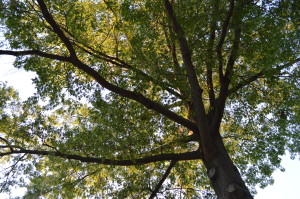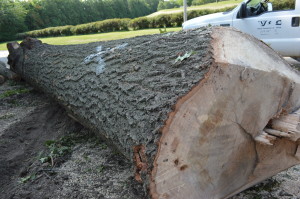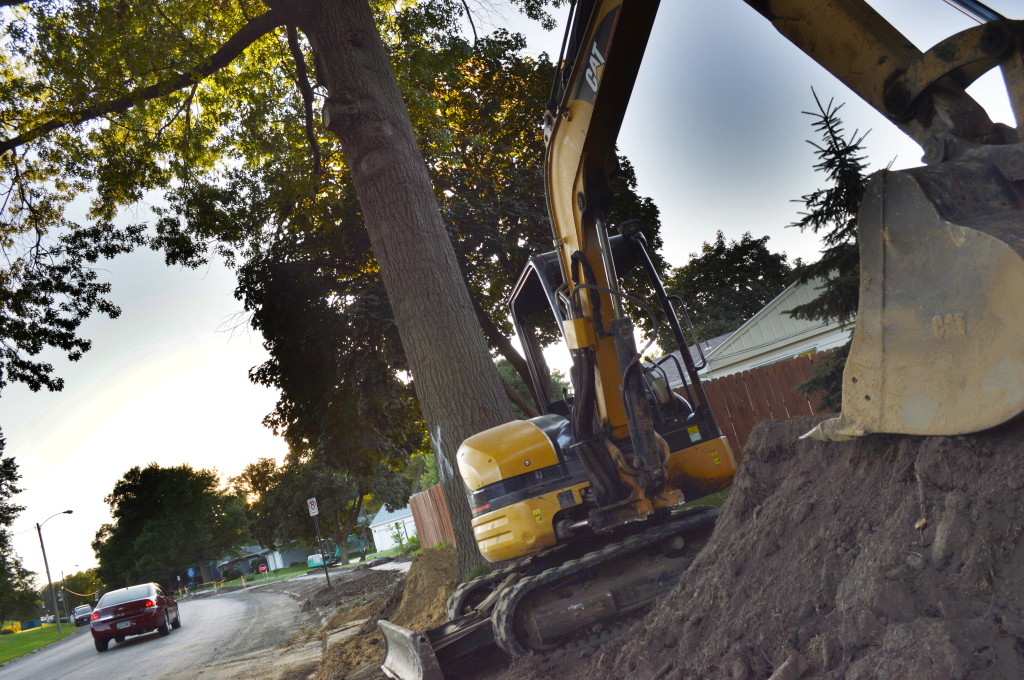
This mature pin oak will be removed in coming days to make way for a sidewalk in Cedar Rapids, Iowa. (photo/Cindy Hadish)
UPDATE: This photo (at right) shows what remained of the once-healthy oak tree as of the end of July 2014.
CEDAR RAPIDS — The Kell family is saying good-bye to their front-yard tree.
It’s not torrential rains, high winds or even a lightning strike that is spelling the end for the mature pin oak. This summer’s storms in Eastern Iowa uprooted and damaged a good number of trees, but the oak will be removed in coming days to make way for pavement.
A “Safe Routes to School” program is funding the installation of sidewalks along Prairie Drive NE, where the Kell family has lived for the past 11 years. During that time, the oak, which sits on city right-of-way, has provided shade and more for their home, as it has for generations before them.
The healthy tree has also been a home and food source for the neighborhood squirrels, as well as other wildlife, Maria Kell noted.
“That’s what I really feel bad about,” she said. “To lose that tree and how it affects the animals and our immediate environment – it’s sad.”
Maria, her husband and their three children have taken pictures of themselves with the tree, which they estimate to be more than 70 years old, but haven’t been told exactly when it will be removed. A white “x” was marked on the tree weeks ago and the sidewalk has inched toward the oak in recent days.
The Kells advocated for installing the sidewalk on the other side of the street, along the campus of Mount Mercy University and Regis Middle School, which is devoid of trees, but were told the grade was flatter on their side, making it more suitable for the wide sidewalks.

This mature pin oak in Cedar Rapids has been home to squirrels and other wildlife for generations, but will soon be removed by the city. (photo/Cindy Hadish)
City arborist Todd Fagan responded to an email about the issue and said the importance of keeping existing trees has been discussed.
He wrote that “there are several reasons why it was placed on the east side of the street (keep in mind these are federal govt./administrator/engineering reasons, not necessarily city arborist reasons):
Mount Mercy and Regis are private, so the “safe route” program apparently does not apply to students attending those schools.
Fagan said he has reviewed most, if not all of the tree removals for the project.
“We have removed a few undesirable trees and trees in poor condition,” he wrote. “One was transplanted. This oak was originally scheduled for protection and the sidewalk was going to curve around it. I forget why it was approved for removal, but I do remember looking at it and approving the action. It was regrettable—I don’t like to remove mature oaks and usually I’m pretty stubborn about it, but the reasoning behind the request was strong enough to be approved.”
The Kells and other homeowners were not assessed to pay for the sidewalk, which is funded through a grant, but assessments will be on the way for other sidewalks under the city’s new “complete streets” policy and sidewalk master plan.
Both were adopted this week by the Cedar Rapids City Council as a way to make the city more walkable and bicycle friendly. The minimum width of a sidewalk will increase to 5-feet; major street projects will be viewed with an eye toward adding bike lanes and other modalities and sidewalks will be added where they currently don’t exist, said Rob Davis, a Public Works engineer.
The street design policy is modeled after Los Angeles County, California, and meets a criteria under the Blue Zones plan to work towards making Cedar Rapids a healthier place for residents.
Davis said 50 to 60 percent of the city doesn’t have sidewalks, so the master plan will include a list of priorities. In those cases of retrofitting sidewalks, the city and homeowners share in the costs, he said.
One resident whose home was flooded during flash floods in late June asked why the city isn’t considering using permeable pavement, which allows rainwater to soak through, rather than run off into the streets, along with rain gardens and other means to lessen the impact of heavy rains.
At this point, the city has not included those measures in its plans.
In the meantime, the Kell family is watching out their window to see when the tree will be removed and Maria Kell agreed that their children will eventually use the sidewalks to ride their bikes to Franklin Middle School.
“That’s the price,” she said. “We love that tree. We’re going to miss it.”



Thank you, Cindy, for caring enough about our “marked” Oak, to inquire and to write about it. I am touched and grateful, that you took notice, and cared!
Thank you for sharing your story, Maria, and please keep us posted on what happens.
This situation is just begging for one of those feel-good human interest surprises wherein a compassionate, talented person gathers the wood from the tree and crafts it into a family heirloom for them.
They started taking her down this morning, Cindy. 🙁